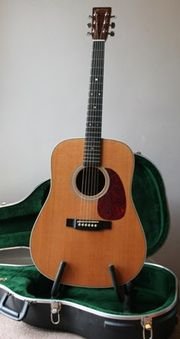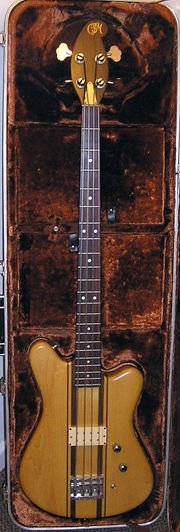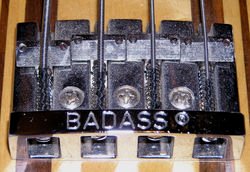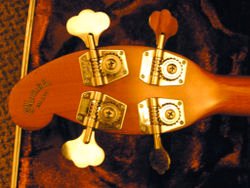
Front detail of CF Martin's very popular 000-28EC model, showing the solid Sitka spruce soundboard, finely inlaid herringbone rosette and
their instantly recognisable, much-copied, trademark "comma-shaped" pickguard
C.F. Martin & Company (Martin) is a US guitar manufacturer that was established in 1833 by Christian Frederick Martin.
Martin is renowned for its high quality acoustic guitars, and is arguably the world's pre-eminent mass manufacturer of flattop acoustics with
models that retail for thousands of dollars and vintage instruments that often fetch 6 figures at resale. The company also made several models
of electric guitars and electric basses.
The company has been run by the Martin family for all of its history; its current chairman and CEO, C.F. 'Chris' Martin IV, is the
great-great-great-grandson of the founder. Many characteristic features of the modern flatop steel strung acoustic guitar were first
introduced by the firm. Some influential creations of the company include the "Dreadnought" body style and scalloped "X bracing".
The company's headquarters and primary factory are in Nazareth, Pennsylvania, located in the Lehigh Valley region of the state.
History
Born in 1796 in Markneukirchen, Germany, C.F. Martin came from a long line of cabinet makers and
woodworkers. By the age of 15 he was an apprentice to Johan Stauffer, a well-known guitar
maker in Vienna, Austria. After completing his training, Martin returned to his hometown and opened
his own guitar-making shop. Shortly after opening he became embroiled in a controversy between two
guilds.
At the time European craftsmen operated under the guild system. The guitar (in its modern form) was a
relatively recent instrument, and most guitar makers were members of the Cabinet Makers Guild. The
Violin Makers Guild began to claim exclusive rights to manufacture musical instruments. Although the
cabinet makers successfully defended their rights to build guitars, Martin decided that the guild system
was too restrictive, and in 1833 he moved to New York City. Apparently uncomfortable with the pace and
style of big-city life, by 1838 he had moved his operation to Nazareth.
In the 1850's Martin developed one of its major technological innovations for the guitar, the "X bracing"
system. The musical and structural integrity of an acoustic guitar is a balance between the need to allow the
soundboard of the guitar to resonate freely for acoustic purposes versus the compensation needed for maintaining
structural integrity over the long term. By gluing struts of wood to the underside of the top of the guitar in a
modified "X" brace pattern, Martin invented a design that successfully met these competing demands: the compromise
being pleasing to the ear of players and listeners as well as the demands of time, with instruments of 100+ years
of age still being eminently playable.
A steel-string guitar tuned to concert pitch can put tension of 180 pounds force (800 N) on the top of the guitar.
The X brace system has been shown to be an efficient technique for preventing the top of the guitar from warping under
this force. The braces are generally carved; being scalloped and tuned in order to aid in the resonance and integrity
of the guitar top, such capability being performed by skilled artisans and not readily reproducable by machine. This
work is an important factor in determining the timbre or "tone" of the guitar, and a major determinant in the observation
that rarely do two guitars ever sound alike even though they are ostensibly identical in construction.
The growing popularity of the guitar in the early 1900s, fueled by the growing popularity of folk music and country and
western music, led to a demand for louder and more percussive guitars. This led to many companies beginning to string
their guitars with metal instead of catgut. These became known as steel-string guitars, and Martin began concentrating on
this type of guitar by 1921.
The company's reputation and production continued to grow. Forays into mandolin making in the late 1890s and ukulele
making in the 1920s greatly contributed to their expansion, and by 1928 they were making over 5000 instruments per year.
However, the Great Depression quickly had a drastic effect on sales, and Martin came up with two further innovations in
an attempt to regain business.
One of these was the 14-fret neck, which allowed a greater range of notes, and which was meant to appeal to banjo players.
Most guitars at the time had only 12 frets where the neck joins the body. This idea became so popular that Martin made the
14-fret neck standard on all of its guitars, and the rest of the guitar industry soon followed.
The second innovation was the Dreadnaught guitar. Originally devised in 1916 as a collaboration between Martin and a
prominent retailer, the Dreadnought body style was larger and deeper than most guitars. This led to its name; at about the
same time the British Navy shocked the world by launching a battleship that was considerably larger than any in service. From
the idea that a ship that big would have to fear nothing, it was christened "HMS Dreadnaught." Martin recognized a perfect
marketing tie-in when they saw one, and borrowed the name for their new, large guitar. The greater volume and louder bass
produced by this expansion in size was intended to make the guitar more useful as an accompaniment instrument for singers.
Poorly received at the time of its introduction, when Martin reintroduced the style in 1931 it quickly became their best-selling
guitar. Again, the rest of the industry soon followed, and today the "Dreadnought" size and shape is considered one of the
"standard" acoustic guitar shapes.
Remaining a family-owned business, the company employed a relatively small number of highly-trained craftsmen making instruments
primarily by hand. This limited production capacity, and by the early 1960s Martin guitars were back-ordered by as long as three
years. In 1964 they opened a new plant which is still the primary Martin production facility.
During the late 1960s, Martin manufactured hollow-body electric guitars similar to those manufactured by Gretsch. Martin's electric
guitars were not popular and the company has since continued to concentrate on the manufacture of a wide range of high quality
acoustics for which its reputation is world-wide and second to none.
In 1979 Martin opens its "Custom Shop" division.
In 1990 Martin builds its 500,000th guitar, and in 2004 they built their millionth guitar.
Models
Six string guitars
For many years Martin has used a model-labeling system that consists of an initial letter or a number or series of zeros that
specifies the body size and type (5 being the smallest and 0000, also called M on some models, being the largest - though not
as large as the dreadnaught - D - or Jumbo -J) followed by a number that designates the guitar's ornamentation and style,
including the species of wood from which the guitar is constructed. Generally, the higher the number, the higher the level of
ornamentation. Additional letters or numbers added to this basic system are used to designate special features (such as a built-in
pickup or a cutaway).
Martin also periodically offers special models. Many of these have a limited production run, or begin as a limited-production
guitar that sells well enough to become regularly produced. Many of these special models are designed with, endorsed by and named
after well-known guitarists such as Eric Clapton, Merle Haggard, Stephen Stills, Paul Simon, Arlo Guthrie, Johnny Cash, and many others.
As of 2005, Martin offers over 180 different guitars. Some of the more notable models are:
-
000-1: Slightly smaller in all dimensions than a "Dreadnought" guitar (the "standard" acoustic guitar), solid
Sitka spruce top, solid mahogany back, laminated mahogany sides, tortoiseshell binding, rosewood fingerboard.
-
000-28EC and 000-28ECB: Two of the five "Eric Clapton" models. Same size as the above guitar, constructed
with higher-quality woods (especially the more expensive 000-28ECB constructed from the extremely rare Brazilian species
of rosewood, hence the "B"), a different shape to the neck, and greater ornamentation around the edge of the body and rose.

000-28EC in Geib-style flight case

HD-28 Dreadnought in moulded flight case
The reasonably priced * 000-28EC (left photograph) is one of Martin's most popular guitars; unlike the bigger
dreadnaughts, the 000-28EC is nearer to the size of a Spanish guitar - a slimmer body and wider fretboard. *
(expect to pay around £2,000 ($3,500) at current Spring 2006 prices - a guitarist's guitar and worth every pound, dollar or
shekel.)
- D-1: Dreadnought version of the "000-1".
- D-18: Dreadnought guitar, solid Sitka spruce top, solid mahogany back and sides.
- D-28: Dreadnought guitar, solid Sitka spruce top, solid East Indian rosewood (Brazilian rosewood before 1969) back
and sides, ebony fingerboard, black and white binding and ornamentation.
The HD-28 (right photograph) is a slightly more ornate version ("H" for herringbone) and is an extrememly popular guitar
with a full sound, good balance between bass and treble and a slightly narrower, rounded neck for ease of playing. Note the
differences in sizes and body shapes of these two standard models.
- D-45: Similar to the "D-28" with much greater and more complex ornamentation, including abalone and
mother-of-pearlshell inlays.
- J-40: a "Jumbo" sized guitar, slightly larger than a Dreadnought but not as deep. Woods similar to the "D-28" and
ornamentation slightly less ornate that the 45 level.
- OM-28 - Similar to the 000-28 model in body size and ornamentation, except with a slightly longer scale. Also known
as the "orchestra" model.
- OM-42PS - Paul Simon's signature acoustic model, based on the OM-28, but with fancier ornamentation. From the original
planned run of around five hundred, only about two hundred and fifty were made, making these a collector's item. The OM-42 is
the nearest in the current range.
- Backpacker: a very small guitar with a body shaped like an elongated triangle, designed to be very portable and
inexpensive while still being constructed of quality woods.
Bass Guitars
EB 18

EB18 Bass Guitar in flight case

EB18 Bass Guitar in flight case
The EB-18 was the first electric bass the Martin company produced in 1979. Previously they had only produced acoustic bass guitars.
The general features of the EB-18 are:
-
- Scale length 34".
- Brass nut,
- Badass bridge,
- Single DiMarzio humbucking pickup,
- Through piece solid construction of hard maple and walnut (body wings are glued on to central core), rosewood fretboard.
- Schaller BM series open tuning heads M/C heads with a gear ratio of 1:20. Some M/C heads have C.F. Martin stamped on them
but look very similar to Schaller heads.
- Four figure serial number printed on the back (where the 'neck' enters the 'body').
- The headstock has the C.F. Martin logo printed on the front. The name C.F.Martin and Co. is printed on the back.
Pickup
The pickup is a DiMarzio DP120 (model 1) dual pole type with a multicore screened lead. This contains red, white, black and green wires
as well as an uninsulated ground wire.
Controls
The EB-18 is provided with a single volume control, one tone control, and a switch for altering the pickup wiring. The switch alters the
tone from a bright to a more bassy sound by cutting one pickup coil out of the circuit.
The tone control is comprised of a 0.1 microfarad capacitor in series with the resistor of the tone control. This network> is placed
directly from the red pickup lead to ground. The volume control is a simple potentiometer wired between the red pickup lead and ground
with the wiper being fed to the output jack.
The control compartment is covered on the rear surface of the body by a polished brass plate. The interior of the compartment is coated
with a light colored conductive paint to act as a screen against unwanted pickup such as mains hum.
Flight case

Badass Bridge on a Martin EB18
The EB-18A was supplied with good quality hard flight case. The EB-18 body fits into the shaped recess and the case takes account
of the odd shaped 'lizard' looking head and large tuning lugs. There are a two of compartments inside for cables etc. The inside is
lined with a soft, burnt orange color, fur-like material. The case is closed with four toggle latches and has a centrally placed
carrying handle.

Martin EB18 Headstock showing Martin machine heads
Popularity
The EB-18 was not all that popular amongst bass players. Their next model the EB 28 was more popular.
EB 28 Bass
Bibliography
-
Washburn, Jim; Johnston, Richard; Stills, Stephen
(2002). Martin Guitars: An Illustrated Celebration of America's Premier Guitarmaker. Pleasantville, NY: Reader's Digest.
ISBN 0762104279.
-
Gura, Philip F. (2003). C.F. Martin and His Guitars, 1796-1973.
Chapell Hill: University of North Carolina Press. ISBN 0807828017.
-
Denyer, Ralph; Guillory, Isaac; Crawford, Alastair M. (1982).
The Guitar Handbook, pp. 36-45, New York: Knopf: Distributed by Random House. ISBN 0394712579.
This article is licensed under the GNU Free Document License
It uses material from the Wikipedia article - C. F. Martin & Company
|
